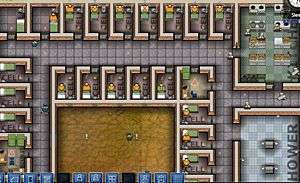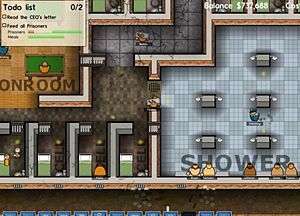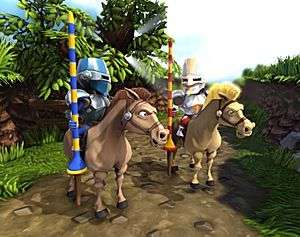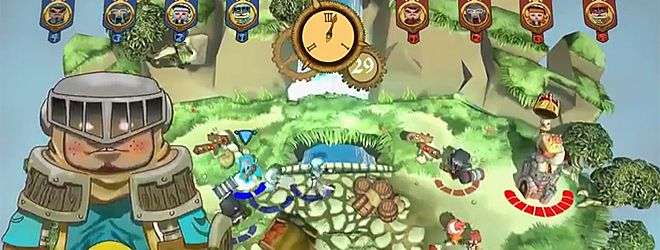Eurogamer Indie Showcase
by Keegan
 Who doesn’t love Indie games? They seem to be all the rage at the moment, with many of the more high-profile indie developers becoming industry darlings almost overnight. Our trip to Eurogamer highlighted this fact, with many indie games running their own stands and a special Indie Arcade making an appearance. Among all those games, there were ones that particularly stood out; some were expected, but others came from out of the blue. Prison Architect was one of those I expected to like, but I was equally impressed by games like IsoChronous and The Last Knight, titles that I’d never heard about, not even in passing.
Who doesn’t love Indie games? They seem to be all the rage at the moment, with many of the more high-profile indie developers becoming industry darlings almost overnight. Our trip to Eurogamer highlighted this fact, with many indie games running their own stands and a special Indie Arcade making an appearance. Among all those games, there were ones that particularly stood out; some were expected, but others came from out of the blue. Prison Architect was one of those I expected to like, but I was equally impressed by games like IsoChronous and The Last Knight, titles that I’d never heard about, not even in passing.
Starting with the most well known of these titles – Prison Architect – would be a logical thing to do, and I’ve been called Vulcan-like in my relentless pursuit of logic, so let’s start with that. As an aside, I’ve also been told I’m a magnificent liar. Prison Architect starts out as what seems to be your standard city-building game, albeit with a slightly different setting. Much of the opening is geared towards setting the player up with the necessary skills to succeed, and, in doing so, also introduces the player to its rather startling aesthetic, which marries the simplistic graphics found in its regular gameplay to the gorgeous artwork that serves as cutscenes. These scenes also give the first hints that Prison Architect is not exactly the bog-standard building simulator that the opening suggests.
 While the tutorial builds up your understanding of the game, it also provides missions that set off a few alarm bells. Chief among those – and the main thrust of the limited story present – was the construction of an execution building, along with an electric chair to occupy it. Suddenly, you’re thrust into a dark story that chronicles the last hours of the death row convict, coupled with flashbacks that explain why he is there in the first place. The juxtapositional presentation of the beautiful (if somewhat harsh) art that details the story against the graphics of the chibi characters acting out the scenes makes for hugely impactful storytelling, often without the need for any sort of narration or subtitles.
While the tutorial builds up your understanding of the game, it also provides missions that set off a few alarm bells. Chief among those – and the main thrust of the limited story present – was the construction of an execution building, along with an electric chair to occupy it. Suddenly, you’re thrust into a dark story that chronicles the last hours of the death row convict, coupled with flashbacks that explain why he is there in the first place. The juxtapositional presentation of the beautiful (if somewhat harsh) art that details the story against the graphics of the chibi characters acting out the scenes makes for hugely impactful storytelling, often without the need for any sort of narration or subtitles.
Suddenly, Prison Architect wasn’t about building prisons any-more. Instead, it was about the prisoners. It was about whether or not it was right to build the device that was going to snuff out a person’s life. Was I really going to just build the machine that would erase this man completely? Suddenly the game was emotional, in a way that the titles it reminded me of – Zeus and Cleopatra – never could be.
On the other hand, the only emotions that IsoChronous conjured were flashes of triumph and frustration in almost equal measures. The whole concept is essentially a duel between two players, with each person taking control of one side of the map and a castle, replete with a grotesque parody of a king. In a simple enough start, each player chooses a character to control from a bunch of combat-focused classes and sets about running around and trying to take each other out, or, failing that, beat up on the opponent king. Rounds last just a minute or two, and when they’re over you do it all again but with different characters. When put like that it seems a far less complex than it really is.
The complication is that every battle is made up of several rounds that are layered on top of each other; after the round is finished – say, with the knight, for example – time rewinds and you select a new character, the round is played again with the same goals, and this is where it gets clever – and a little complicated. The character that you played as in the first round continues to run around and perform the same actions as before – exactly the same as before – but with no allowances made for what your opponent is now doing. It can be a pretty hilarious sight watching your previous character hacking at thin-air for a few seconds before moving on to something else equally non-existent, or at least it is until you realise that you’ve been concentrating so hard on your last character that you’ve been ignoring your new one. And now they’re both dead. That’s okay; you can continue to run around in a ghostly form performing all the actions that you would if alive, but with none of the results. This round.
 Time rewinds again, with all your characters coming back to life (if they died) and plays out again, with your previous characters doing their thing while you try and figure out the best strategy to make sure that when the final round ends you will come out with the victory. It took more than a few matches before the strategies that make up the game began to sink in; the whole time I was playing I had to be thinking about both the previous round and the next one, and it took my brain a while to fall into that pattern of thinking. I never actually got to the point where I was good at the game, or even to the point where I won a match, but eventually it all clicked in my brain and I started enjoying it more and more.
Time rewinds again, with all your characters coming back to life (if they died) and plays out again, with your previous characters doing their thing while you try and figure out the best strategy to make sure that when the final round ends you will come out with the victory. It took more than a few matches before the strategies that make up the game began to sink in; the whole time I was playing I had to be thinking about both the previous round and the next one, and it took my brain a while to fall into that pattern of thinking. I never actually got to the point where I was good at the game, or even to the point where I won a match, but eventually it all clicked in my brain and I started enjoying it more and more.
IsoChronous makes you think in curves instead of straight lines and rewards you generously for out-thinking your opponent rather than recklessly attacking. It takes a peculiar method of thinking, but it’s great fun when it all falls into place. The apparent lack of a single-player mode does make me a bit apprehensive, but as a multiplayer experience it’s absolutely fantastic.
 On other end of the scale is the Last Knight, which was a totally solo experience. The player takes on the role of the titular knight who seems to be on a quest to ride around on his horse a lot. Not the best story I admit, but the game itself was great fun. Essentially an on-rails jouster, you direct your cartoony knight and equally cartoony horse through, over and around increasingly tougher obstacles and environments. Along the way you come across enemies, which is where the jousting element comes into play. When The Knight lowers his lance he gets a speed boost until he lifts it again. The speed boost makes it easier to take out your enemies, but minimises your horse’s handling. Obviously it’s a male horse, because it can only focus on one thing.
On other end of the scale is the Last Knight, which was a totally solo experience. The player takes on the role of the titular knight who seems to be on a quest to ride around on his horse a lot. Not the best story I admit, but the game itself was great fun. Essentially an on-rails jouster, you direct your cartoony knight and equally cartoony horse through, over and around increasingly tougher obstacles and environments. Along the way you come across enemies, which is where the jousting element comes into play. When The Knight lowers his lance he gets a speed boost until he lifts it again. The speed boost makes it easier to take out your enemies, but minimises your horse’s handling. Obviously it’s a male horse, because it can only focus on one thing.
As you progress, the environments the duo sprint through become more elaborate and far-fetched; highlights include an area where you have to hop between islands suspended in the air and another sees you race through claustrophobic tunnels whilst running bats through with your lance. The Last Knight is simple on the surface, but it channels that addictive “one more go” aspect with aplomb, and when you do falter you find that clicking that retry button becomes a matter of instinct over choice. It’s great fun blitzing through zone after zone, and the sense of accomplishment it furnishes you with at the end of a level is immense. At the end of the day it’s just a bit of fun, but it is seriously fun.
Last five articles by Keegan
- I Heart... Quiplash
- What's a Blood Sport Without Personality?
- XCOM and the Art of Permanence
- Pokken Tournament - Review
- Failure to Launch




















Fantastic article, Keegs. No Luca No has to be in the next one though!